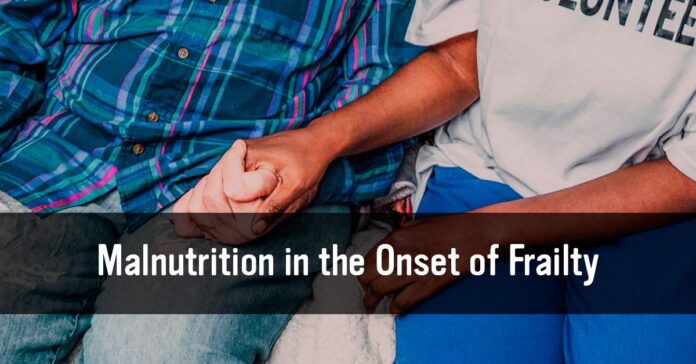Introduction
The improvement of care and the extension of life expectancy have led to a significant increase in the number of elderly people in Western countries and thus in pathologies associated with aging. One of the main consequences of aging is the development of frailty in older individuals, which leads to an increased susceptibility to deteriorations in their health status. Frailty is the result of the interaction of many factors, among which malnutrition is significant. In this report, we will specifically look at how malnutrition promotes the onset of frailty and what its causes are.
I – Frailty
Frailty is a state that appears with aging and is characterized by an increased sensitivity to rapid degradations of the physiological state of individuals, which can lead to a more significant deterioration of their health status, or even death. The causes of frailty are multiple and involve complex relationships between physical and psychosocial factors.
Physical factors primarily include the decreased ability of older adults to perform daily life tasks, the main cause of which is sarcopenia, i.e., the progressive degradation of muscle mass and strength with age1. Indeed, individuals with sarcopenia are limited by their low physical strength while experiencing earlier sensations of fatigue, thus reducing their daily activities. Sarcopenia is caused both by an increase in inflammation associated with aging2 and by malnutrition, which is characterized by a decreased daily protein intake in these individuals3.
Psychosocial factors include cognitive changes, particularly mood changes that foster depression and/or anxiety, the social environment of individuals, as well as the presence of comorbidities1. Interactions between psychosocial and physical factors are numerous and create and fuel a pathological vicious cycle leading to the state of frailty. More specifically, psychosocial factors promote the emergence of physical factors by decreasing the motivation of older adults to engage in daily life activities, including physical activity as well as social activities. Physical activity has a significant beneficial effect at the cognitive level4, and its reduction along with that of social activities will feed into the depression and/or anxiety of individuals and thus, this pathological vicious cycle. Additionally, these two phenomena promote malnutrition in older adults by decreasing daily caloric intake. Consequently, sarcopenia may develop more easily, which will limit individuals’ ability to perform daily life tasks, including social activities. The social isolation of this person will therefore become even more significant, further fueling the vicious cycle responsible for this person’s state of fraility.
Malnutrition contributes to the onset of frailty through its involvement in the development of sarcopenia, and more specifically the decrease in muscle mass. It is therefore necessary to understand the causes of this malnutrition.
II- Anorexia Related to Aging
In addition to the briefly mentioned factors above, anorexia progressively develops in older adults, whose main consequence is a decrease in food intake5, which will be the origin of the malnutrition observed in these individuals2.
As with frailty, the causes of anorexia are both biological and psychosocial. Indeed, aging is associated with a decrease in hunger sensations, as well as an alteration of taste and smell, the two senses essential for the body to appreciate food and drinks. These changes lead to a decrease in food intake, with an increasingly less varied diet drastically reducing daily caloric intake and promoting malnutrition.
Furthermore, mood changes such as anxiety or depression are also powerful inhibitors of appetite, thereby promoting anorexia related to aging; however, these are reversible with appropriate management. Many social factors also play a significant role in the development of anorexia, including the isolation of the elderly6. Indeed, since meals play an important social role for individuals, the feeling of isolation, particularly among widows and widowers, reinforces the depression and/or anxiety of these people. Additionally, it should also be noted that these individuals may have cognitive disorders that limit them in meal preparation, in addition to physical limitations related to sarcopenia, which make shopping or even standing difficult5.
Conclusion
The onset of malnutrition linked to the development of anorexia during aging is a major factor in the appearance of sarcopenia and the state of frailty in older adults. This malnutrition is the consequence of an interaction between biological, physical, and psychosocial factors that must be taken into account to limit the occurrence of this condition and ensure healthy aging for the elderly.
References
- Cruz-Jentoft AJ, Kiesswetter E, Drey M, Sieber CC. Nutrition, frailty, and sarcopenia. Aging Clin Exp Res. févr 2017;29(1):43‑8.
- Cruz-Jentoft AJ, Bahat G, Bauer J, Boirie Y, Bruyère O, Cederholm T, et al. Sarcopenia: revised European consensus on definition and diagnosis. Age Ageing. janv 2019;48(1):16‑31.
- Franzke B, Neubauer O, Cameron-Smith D, Wagner KH. Dietary Protein, Muscle and Physical Function in the Very Old. Nutrients [Internet]. 20 juill 2018 [cité 26 avr 2021];10(7). Disponible sur: https://www.ncbi.nlm.nih.gov/pmc/articles/PMC6073115/
- Pedersen BK, Saltin B. Exercise as medicine – evidence for prescribing exercise as therapy in 26 different chronic diseases. Scand J Med Sci Sports. déc 2015;25 Suppl 3:1‑72.
- Sanford AM. Anorexia of aging and its role for frailty. Curr Opin Clin Nutr Metab Care. janv 2017;20(1):54‑60.
- Tsutsumimoto K, Doi T, Makizako H, Hotta R, Nakakubo S, Makino K, et al. Aging‐related anorexia and its association with disability and frailty. J Cachexia Sarcopenia Muscle. oct 2018;9(5):834‑43.


